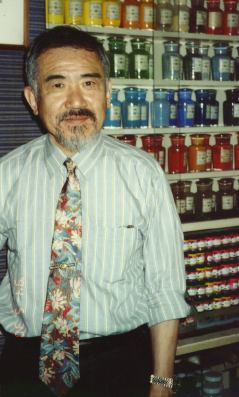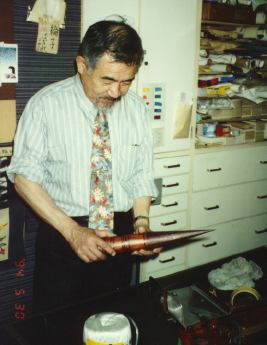Mr. Kazuyuki Matsuyoshi, pigment
supplier
I was looking forward to my visit this time, out
gathering information for my 'Hyaku-nin Issho' newsletter, because it
took me to my favourite part of Tokyo, an area to which I return time
and time again, whenever I have a chance. No, not Asakusa, where many
of the woodblock craftsmen live and work, although of course I also
love going there, but this time to the Kanda and Jimbocho district.
It's that stretch of Yasukuni-dori from Kudanshita along to
Ogawamachi that is the magnet for me ... the dozens and dozens of
second-hand bookshops all in a long row. Usually, once I get started
browsing through these shops, I can pretty much forget about getting
anything else done for the rest of the day, but this time, when I
came out from the Jimbocho subway station and headed eastwards, I had
to steel myself to walk right by all the beckoning mountains of
books. Today's mission was different, a visit to the shop of Mr.
Kazuyuki Matsuyoshi, dealer in pigments of every description, and the
place where I obtain the ganryo, the colours with which I
make my prints.
 Not too
long ago, I would have found his store in an old brown wooden
building, but the pressure from the real estate developers put an end
to that, and the shop now occupies the ground floor space in a tall
modern building. Similar steel and concrete buildings crowd around on
both sides, as the old wooden buildings of this block, which narrowly
escaped the fires during the war, have all since fallen to less
dramatic, but just as effective, forms of destruction. But once
inside the shop, such thoughts become irrelevant, as one is
surrounded by shelf after shelf, row upon row, of jars of coloured
pigments ... stacked from floor to ceiling, up far higher than I can
reach. You would like some green pigment? On a few shelves just
inside the door stand 92 jars of green, each one different from its
neighbour. How about some yellow? More than 50 choices. What about
some white? What choice can there be for white? But here I see more
than four dozen different white shades standing ready for your
choice! And these are all just one particular type of pigment.
Similar selection of other types surround on every side. Here on Mr.
Matsuyoshi's shelves, and down in his storerooms, are hundreds and
thousands of different pigments, made from materials from all parts
of the world, waiting for use by all types of artists.
Not too
long ago, I would have found his store in an old brown wooden
building, but the pressure from the real estate developers put an end
to that, and the shop now occupies the ground floor space in a tall
modern building. Similar steel and concrete buildings crowd around on
both sides, as the old wooden buildings of this block, which narrowly
escaped the fires during the war, have all since fallen to less
dramatic, but just as effective, forms of destruction. But once
inside the shop, such thoughts become irrelevant, as one is
surrounded by shelf after shelf, row upon row, of jars of coloured
pigments ... stacked from floor to ceiling, up far higher than I can
reach. You would like some green pigment? On a few shelves just
inside the door stand 92 jars of green, each one different from its
neighbour. How about some yellow? More than 50 choices. What about
some white? What choice can there be for white? But here I see more
than four dozen different white shades standing ready for your
choice! And these are all just one particular type of pigment.
Similar selection of other types surround on every side. Here on Mr.
Matsuyoshi's shelves, and down in his storerooms, are hundreds and
thousands of different pigments, made from materials from all parts
of the world, waiting for use by all types of artists.
The shop has been here for about 60 years, and was
set up by Mr. Matsuyoshi's father, originally as an offshoot of a
family business in Kyoto. I had guessed that it would have been a
desire to be near artists and book publishers that led him to choose
this area for his business, but it seems that this was not the case.
Rather it was the proximity to businesses involved in making
clothing, who needed various dyes and pigments, and who were once
common in this area, that dictated the choice. Times have changed
though, and Mr. Matsuyoshi's clientele is no longer purely 'local' in
scope. It now includes not only people working with fabric dyeing,
but woodblock printmakers like myself, 'kamban' (sign) designers, and
of course the Japanese 'nihonga' painters for whom those 92 jars of
green are waiting ... His customers are found all over Japan, and the
shop even makes some shipments overseas, although Matsuyoshi-san
admits that unless he improves his English, this will necessarily
remain a minor part of his business ...
There have been some exciting times.
Matsuyoshi-san was only a young boy, and thus shipped out to the
countryside during the wartime years, but he certainly remembers the
time about fifteen years ago when they had a disastrous fire in their
storehouse. He has vivid memories of the firemen coming out of the
building in their 'new' multi-coloured uniforms. Spraying water over
mountains of coloured pigments may seem funny in retrospect, but the
clouds of smoke coming from burning toxic materials was probably
anything but funny at the time ...
 Most of
the products in the shop are now sold in a prepared 'ready-to-use'
form, but a small row of jars across the top of a cabinet gives
testimony as to how the business has changed down the years. In these
jars is a collection of some of the raw materials from which various
traditional colours are made: flower petals, seeds, cones, etc.
Reading the labels ('benibana', 'yamamomo', 'yashiyadama', 'ukon'
...) brings up memories of a vocabulary not often heard nowadays ...
as the dust on the jars can testify. But I should not leave the
impression that this is a dessicated old shop. During the couple of
hours that I sit chatting with Mr. Matsuyoshi, the telephone and fax
work continuously. His assistants wrap and pack a number of large
boxes to be shipped out, and there is a general hum of activity.
Most of
the products in the shop are now sold in a prepared 'ready-to-use'
form, but a small row of jars across the top of a cabinet gives
testimony as to how the business has changed down the years. In these
jars is a collection of some of the raw materials from which various
traditional colours are made: flower petals, seeds, cones, etc.
Reading the labels ('benibana', 'yamamomo', 'yashiyadama', 'ukon'
...) brings up memories of a vocabulary not often heard nowadays ...
as the dust on the jars can testify. But I should not leave the
impression that this is a dessicated old shop. During the couple of
hours that I sit chatting with Mr. Matsuyoshi, the telephone and fax
work continuously. His assistants wrap and pack a number of large
boxes to be shipped out, and there is a general hum of activity.
I am not a very good customer of this shop, as I
don't make very many prints, and each small packet of inexpensive
pigment that I buy lasts me for years on end, but hopefully most of
his clients are more productive than I, and his business will be able
to survive well into the future. I certainly hope so, because it is
an important link in the chain of craftsmen and suppliers without
whom I could not continue my work. But of course, I shouldn't say
that, because all of those links are vital, none more important than
any another. If any one of them were to break, the entire process of
making my prints would come to a halt. Matsuyoshi-san, thank you for
keeping up your business when all around you are giving up and
selling out to those giant sports shops that are taking over your
district. I promise to try and get my nose out of the bookshops, and
come and visit a bit more often!